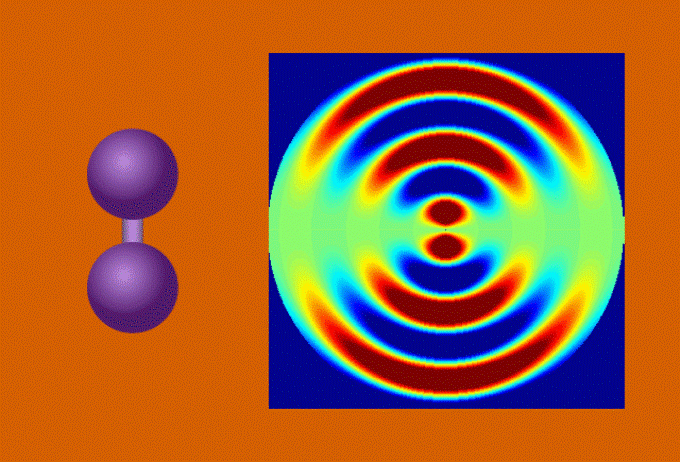Sep 1 2016
 The electron diffraction pattern from iodine molecules depends on the distance between the two iodine nuclei, and changes as the molecule vibrates. (SLAC National Accelerator Laboratory)
The electron diffraction pattern from iodine molecules depends on the distance between the two iodine nuclei, and changes as the molecule vibrates. (SLAC National Accelerator Laboratory)
The Department of Energy’s SLAC National Accelerator Laboratory has used its ultrafast electron camera for the first time, to get direct snapshots of atomic nuclei in molecules that are vibrating within millionths of a billionth of a second after being stroked by a laser pulse.
This technique, known as ultrafast electron diffraction (UED), could help scientists to improve their understanding of the role of nuclear motions in light-driven processes that naturally take place on extremely rapid timescales.
Researchers used the electron beam of the UED instrument to observe the iodine molecules at varied points in time after the laser pulse. They stitched the images to obtain a "molecular movie" that exhibits the molecule vibrating and the bond existing between the two iodine nuclei stretching almost 50% - from 0.27 to 0.39 millionths of a millimeter - before going back to its original state.
A single vibrational cycle took almost 400 femtoseconds; one femtosecond, or millionth of a billionth of a second, is the time taken by light to pass through a small fraction of the width of a human strand of hair.
We’ve pushed the speed limit of the technique so that we can now see nuclear motions in gases in real time. This breakthrough creates new opportunities for precise studies of dynamic processes in biology, chemistry and materials science.
Xijie Wang, Lead UED Scientist, SLAC
Since the 1980s, a number of groups from all over the world have been working on the UED method. However, the quality of electron beams has only recently become good enough to be used in femtosecond studies.
SLAC’s instrument obtains benefits from an ultrabright, high-energy electron source, originally created for the lab’s femtosecond X-ray laser, the Linac Coherent Light Source (LCLS), a DOE Office of Science User Facility.
The results will be featured in Physical Review Letters.
A Direct Way of Looking at Nuclear Motions
Physicists have long been aware of the fact that chemical bonds between atoms are flexible, just like springs connecting spheres. This flexibility enables molecules to modify their shapes in ways that are important for chemical and biological functions, such as photosynthesis and vision. However, techniques to study these motions on a femtosecond timescale have continued to be indirect.
For example, spectroscopy understands these modifications based on the way laser light interacts with electron clouds surrounding atomic nuclei, and also needs theoretical calculations to convert this data into a picture of the nuclear geometry.
This can be accurately performed for small molecules - an achievement through which the late Ahmed Zewail, a pioneer in the field of femtochemistry, obtained the 1999 Nobel Prize in Chemistry - but becomes extremely difficult for bigger molecules.
X-rays are also used to analyze ultrafast molecular motions. Even though X-rays penetrate deeply into the electron clouds and interact with the electrons nearest to the nuclei, they do not yet do so with resolution that is high enough to accurately determine the nuclear positions in existing femtosecond X-ray studies.
In comparison to this, the UED uses a beam of extremely energetic electrons that work together with both electrons and atomic nuclei present in molecules. The UED is capable of directly probing the nuclear geometry with high resolution.
We previously used the method to look at the rotation of molecules – a motion that doesn’t change the nuclear structure. Now we have demonstrated that we can also see bond changes due to vibrations.
Jie Yang, SLAC
A Molecular Double-slit Experiment
The idea behind the iodine UED experiment is similar to the standard double-slit experiment often illustrated in physics classrooms. In this experiment, a laser beam travels through a pair of vertical slits, developing an interference pattern of dark and bright areas on a screen. The pattern relies on the distance that exists between the two slits.
With UED, an electron beam shines through a gas of iodine molecules and the distance between the two iodine nuclei in each molecule defines the double slit and strikes a detector instead of a screen. The detector’s intensity pattern is called the diffraction pattern.
The characteristic pattern tells us immediately the distance between the nuclei, but we can learn even more. As the iodine molecules vibrate, the diffraction pattern changes, and we can follow the changes in nuclear separation in real time.
Markus Guehr, Potsdam University in Germany and the Stanford PULSE Institute
A Method with Perspectives
Co-principal investigator Martin Centurion from the University of Nebraska, Lincoln, said, “What’s also great about our method is that it works for every molecule. Unlike other techniques that depend on the ability to calculate the nuclear structure from the original data, which works best for small molecules, we only need to know the properties of our electron beam and experimental setup.”
The researchers followed their initial steps by using the comparatively simple iodine molecule, and are currently planning to expand their research on molecules with more than two atoms.
The development of UED into a technique that can probe changes in internuclear distances of a dilute gas sample in real time truly is a great achievement. This opens the door to studies of atomic-level motions in many systems – structural dynamics that are at the heart of the correlation between structure and function in matter.
Jianming Cao, UED Expert, Florida State University
The DOE Office of Science partially funded the research.